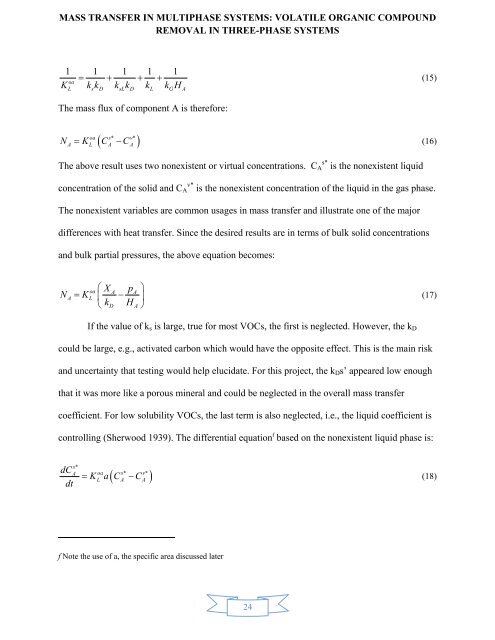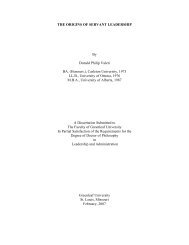mass transfer in multiphase systems - Greenleaf University
mass transfer in multiphase systems - Greenleaf University
mass transfer in multiphase systems - Greenleaf University
You also want an ePaper? Increase the reach of your titles
YUMPU automatically turns print PDFs into web optimized ePapers that Google loves.
MASS TRANSFER IN MULTIPHASE SYSTEMS: VOLATILE ORGANIC COMPOUND<br />
REMOVAL IN THREE-PHASE SYSTEMS<br />
1 1 1 1 1<br />
(15)<br />
oa<br />
KL kskD ksLkD kL kGHA<br />
The <strong>mass</strong> flux of component A is therefore:<br />
<br />
oa s* v*<br />
A L A A<br />
<br />
N K C C<br />
(16)<br />
The above result uses two nonexistent or virtual concentrations. C A s* is the nonexistent liquid<br />
concentration of the solid and C A v* is the nonexistent concentration of the liquid <strong>in</strong> the gas phase.<br />
The nonexistent variables are common usages <strong>in</strong> <strong>mass</strong> <strong>transfer</strong> and illustrate one of the major<br />
differences with heat <strong>transfer</strong>. S<strong>in</strong>ce the desired results are <strong>in</strong> terms of bulk solid concentrations<br />
and bulk partial pressures, the above equation becomes:<br />
N<br />
A<br />
K<br />
X<br />
<br />
p<br />
oa A A<br />
L <br />
kD<br />
HA<br />
<br />
<br />
<br />
<br />
(17)<br />
If the value of k s is large, true for most VOCs, the first is neglected. However, the k D<br />
could be large, e.g., activated carbon which would have the opposite effect. This is the ma<strong>in</strong> risk<br />
and uncerta<strong>in</strong>ty that test<strong>in</strong>g would help elucidate. For this project, the k D s’ appeared low enough<br />
that it was more like a porous m<strong>in</strong>eral and could be neglected <strong>in</strong> the overall <strong>mass</strong> <strong>transfer</strong><br />
coefficient. For low solubility VOCs, the last term is also neglected, i.e., the liquid coefficient is<br />
controll<strong>in</strong>g (Sherwood 1939). The differential equation f based on the nonexistent liquid phase is:<br />
dC<br />
dt<br />
s*<br />
A<br />
oa<br />
L<br />
<br />
s* v*<br />
A A<br />
<br />
K a C C<br />
(18)<br />
f Note the use of a, the specific area discussed later<br />
24



